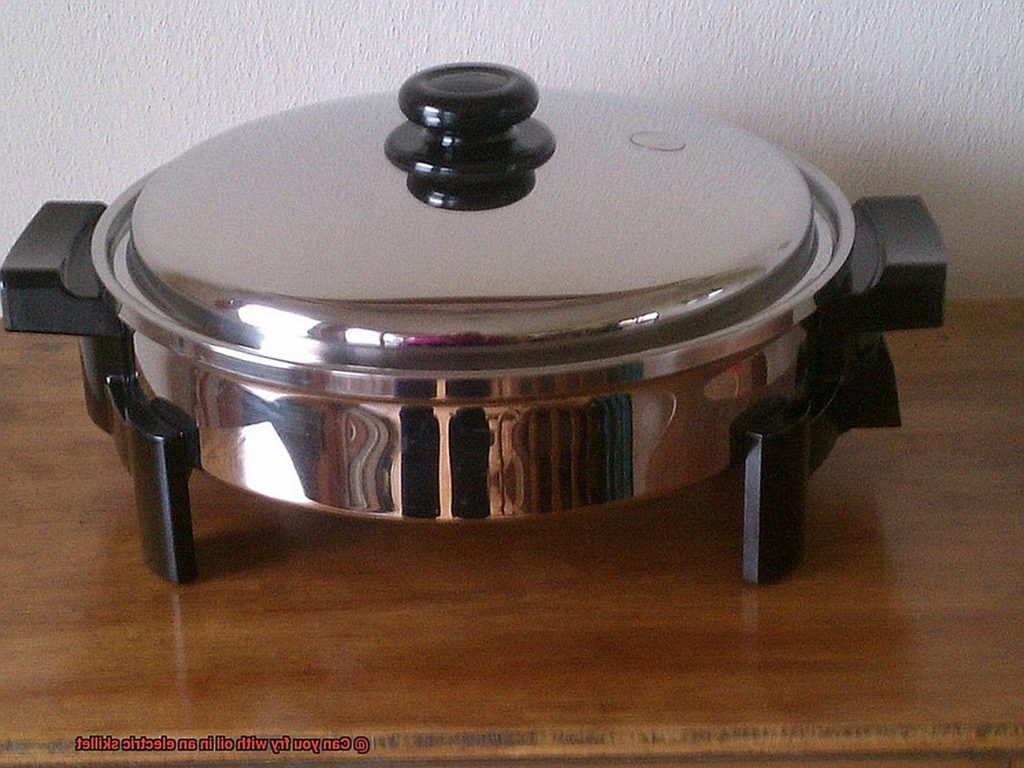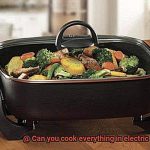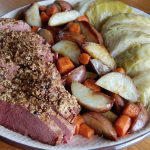Are you tired of the grease splatters and burnt oil stains on your stove every time you fry your favorite foods? Or maybe you’re looking for a more convenient way to cook without having to babysit the stove. Enter the electric skillet – a versatile kitchen gadget that’s been gaining popularity over the years. But can you really fry with oil in an electric skillet? The answer is a resounding yes, and it might just change your culinary game.
Electric skillets are designed to offer a portable, non-stick surface that can cook a variety of foods, including crispy fried goodness. However, before you start pouring oil into your skillet, there are some things to consider. Temperature control and skillet size are crucial factors that will determine whether your food cooks evenly or sticks to the surface.
Using an electric skillet for frying has several advantages too. The temperature control allows for consistent heat, resulting in perfectly cooked food every time. Plus, the non-stick surface means less oil is needed, making your dishes healthier without sacrificing flavor. And let’s not forget about the easy-to-clean surface that saves you precious time scrubbing pots and pans.
In this post, we’ll take a deep dive into the world of electric skillet frying – exploring its benefits, how to use it properly for frying, and some mouth-watering recipes to try out. So sit back, relax, and get ready to take your cooking skills up a notch with an electric skillet.
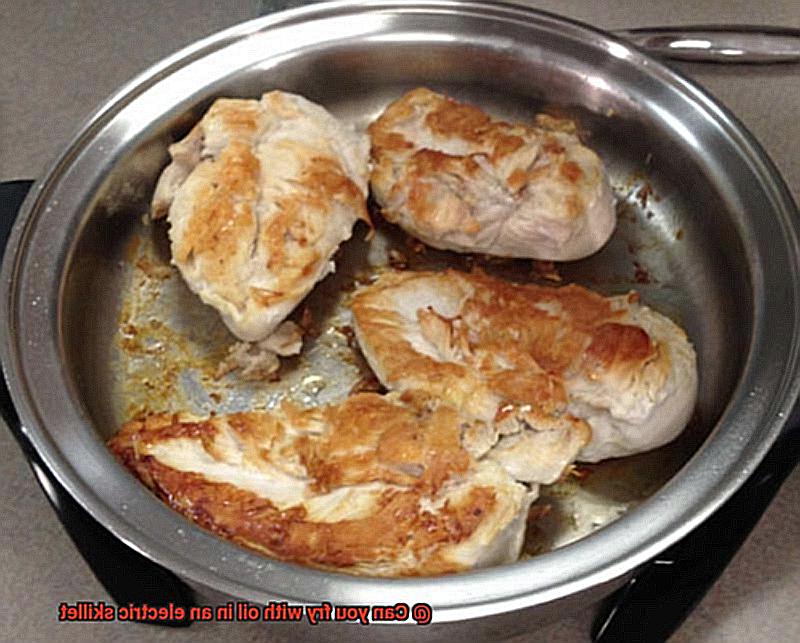
Contents
What is an Electric Skillet?
Look no further than an electric skillet. This versatile kitchen appliance functions as a portable stovetop, providing even heating and precise temperature control. With an electric skillet, you can fry, sauté, braise, and even bake a variety of dishes with ease.
Electric skillets come in different shapes and sizes, from round to square or rectangular. They are made of different materials such as aluminum or stainless steel. The temperature of the skillet is easily controlled, allowing for precise cooking and frying. Whether you’re cooking up stir-fries or stews, an electric skillet ensures that your dishes are cooked to perfection.
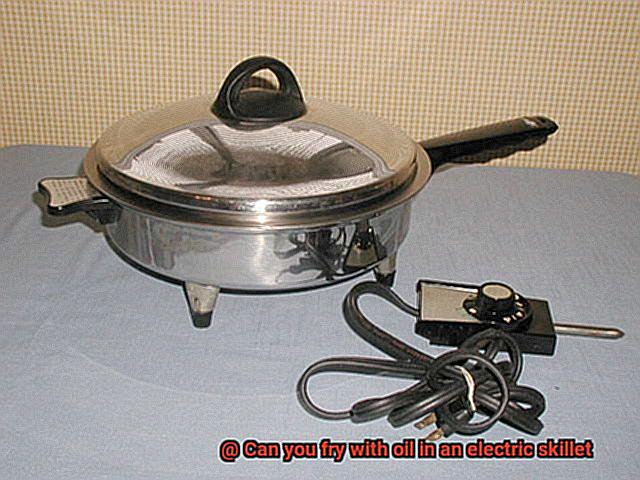
One of the most significant advantages of an electric skillet is its ability to maintain a consistent temperature, making it ideal for frying with oil. To achieve crispy and delicious results when frying, it’s important to use the right type of oil. Vegetable oils like canola, soybean, or peanut oil are ideal for frying because they have high smoke points and can withstand high temperatures without burning. In contrast, olive oil is not recommended for frying because it has a low smoke point and can burn easily.
Using an electric skillet for frying is easy. Ensure that the skillet is clean and dry before adding enough oil to cover the bottom by about 1/4 inch. Heat the skillet to the desired temperature (usually between 350°F and 375°F), and avoid overcrowding the skillet when adding food. Fry food in batches and turn it occasionally for even cooking.
Not just for frying, electric skillets are versatile appliances that can be used for various dishes. Some electric skillets even come with a lid, making them perfect for simmering or braising dishes that require slow and steady cooking.
Electric skillets also have other convenient features that make them easy to use. Many come with non-stick surfaces that prevent food from sticking to the pan, making cleaning up after cooking a breeze. They also have heat-resistant handles that make them safe to handle even when hot.
Advantages of Frying with an Electric Skillet
You need to switch to an electric skillet for all your frying needs. As an expert in the advantages of frying with an electric skillet, let me tell you, it’s a game-changer.
One of the most significant benefits of using an electric skillet is precise temperature control. Unlike traditional stovetops, which can have hot spots that make it difficult to maintain a consistent temperature, electric skillets allow you to set and maintain the temperature throughout the cooking process. This means no more burnt edges or under-cooked centers, just perfectly crispy and evenly cooked food every time.
In addition to precise temperature control, electric skillets offer even heat distribution. Gone are the days when your food would have cold or hot spots affecting its texture and taste. The larger cooking surface of electric skillets also makes it possible to cook more food at once, saving time and effort.
Cleaning up after cooking is always a hassle, but electric skillets make it easy. The non-stick surface ensures that food doesn’t stick to the surface, making cleanup quick and effortless. You can even throw them in the dishwasher for a hassle-free cleaning experience.
Finally, the portability of electric skillets is a great advantage. You can use them anywhere there is an electrical outlet – whether you’re cooking outdoors or have limited counter space in your kitchen. This makes them a versatile tool for any cook who loves fried foods.
Types of Oil to Use for Frying
Frying food is an art form that requires the right tools, ingredients, and techniques. One of the most important ingredients for frying is oil, as it not only affects the flavor and texture of the food but also its safety. When it comes to frying in an electric skillet, it’s crucial to choose an oil with a high smoke point to avoid smoke and harmful compounds from being released into the air. In this article, we’ll explore the differences between the types of oils that can be used for frying in an electric skillet.
Vegetable Oil
Vegetable oil is a popular choice for frying due to its high smoke point, availability, and affordability. However, it’s important to note that vegetable oil is highly processed and contains a lot of omega-6 fatty acids, which can be harmful when consumed in excess. Additionally, its neutral flavor may not add much depth to the taste of fried foods.
Canola Oil
Canola oil is another popular option for frying because of its high smoke point and neutral flavor. It contains less saturated fat than other oils and is rich in monounsaturated and polyunsaturated fats, making it a healthier option. Canola oil is versatile and can be used for a variety of fried foods.
Peanut Oil
Peanut oil has a high smoke point and a nutty flavor that adds depth to fried foods. It is also low in saturated fat and high in monounsaturated fat, making it a healthier option than some other oils. Additionally, peanut oil can be reused several times before needing to be discarded.
Sunflower Oil
Sunflower oil is a good option for frying as it has a high smoke point and a neutral flavor that won’t overpower the taste of the food. It is also high in vitamin E, an antioxidant that helps protect against cell damage.
Olive Oil
While not ideal for deep-frying due to its low smoke point, olive oil can be used for shallow-frying or sautéing. It has a rich flavor and is high in heart-healthy monounsaturated fats. However, using olive oil for high-temperature frying can lead to the oil breaking down and releasing harmful compounds.
It’s important to note that some oils should be avoided when frying in an electric skillet. Butter, margarine, and coconut oil have low smoke points and can burn easily, leading to smoke and even a fire hazard. Olive oil also has a low smoke point and can quickly become bitter when heated.
Preparing the Electric Skillet for Frying
Before you start heating up that oil, it’s important to properly prepare your skillet to ensure that your food cooks evenly and doesn’t stick to the surface. As an expert in preparing electric skillets for frying, I am here to guide you through the process.
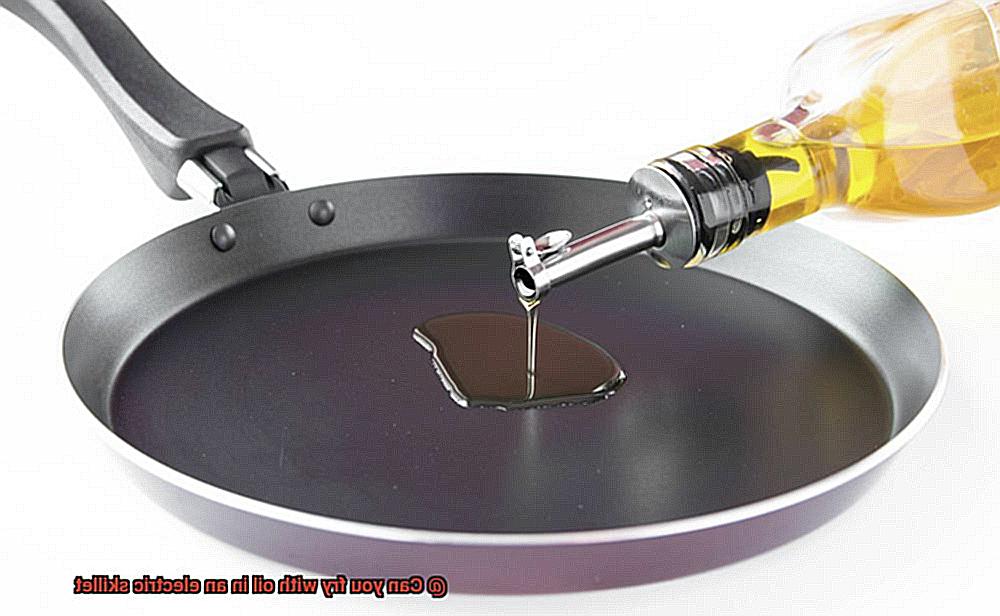
Step 1: Clean the Skillet
The first step in preparing your electric skillet for frying is to clean it thoroughly. Any leftover food particles from previous use can affect the taste of your food and cause it to stick to the surface. To clean the skillet, use a gentle detergent and warm water, then dry it with a soft cloth.
Step 2: Season the Skillet
Seasoning your electric skillet is a crucial step in creating a non-stick surface for frying. It involves coating the inside surface of the skillet with oil and heating it for a few minutes. This process helps to prevent food from sticking while creating an even cook.
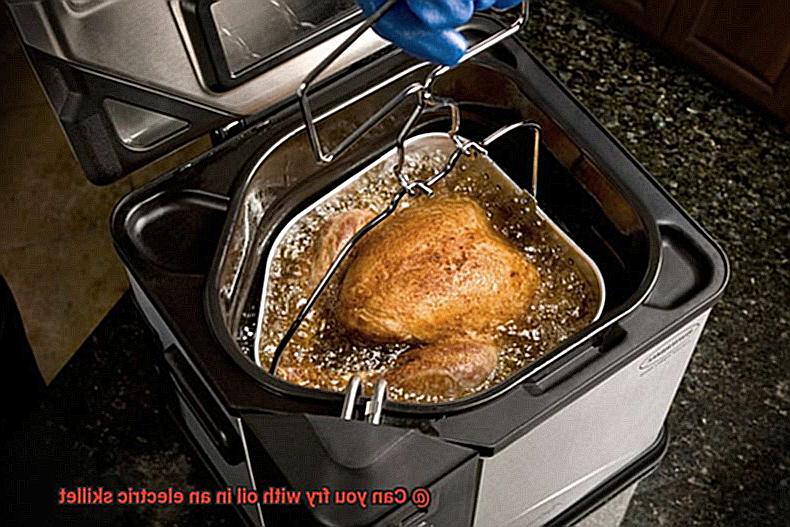
To season your electric skillet, apply a thin layer of vegetable oil or shortening on the cooking surface of the skillet, making sure to cover the entire surface evenly. Turn the electric skillet on to a medium heat setting and allow it to heat up for 10-15 minutes. You may notice some smoke during this process, but don’t worry, it’s normal.
After heating for 10-15 minutes, turn off the electric skillet and let it cool down completely. Once cooled, use a paper towel or soft cloth to wipe away any excess oil. Your electric skillet is now seasoned and ready for use.
Step 3: Maintain Your Skillet
Maintaining your electric skillet is just as important as seasoning it. Periodically re-seasoning ensures that your skillet maintains its non-stick surface over time. Additionally, be sure not to use abrasive materials or harsh detergents when cleaning your skillet as this can damage the non-stick surface.
Heating the Oil in the Electric Skillet
As someone who knows their way around an electric skillet, let me tell you – heating the oil is a game-changer when it comes to frying food. It’s the key to achieving that perfect texture and flavor that we all crave. So, let me guide you through the steps to ensure your next fried dish is a success.
First and foremost, temperature control is crucial. Electric skillets come equipped with this fantastic feature that allows you to adjust the heat to your liking. This means you can maintain a consistent temperature throughout the frying process, resulting in evenly cooked food. So, before you even think about adding any ingredients, make sure to set the temperature to your desired level.
Now, let’s talk about oil. Pour in the desired amount of oil but be mindful not to overfill it as this can cause a safety hazard. Once you’ve added the oil, give it a few minutes to heat up before adding any food. This will ensure that it’s at the optimal temperature for frying.
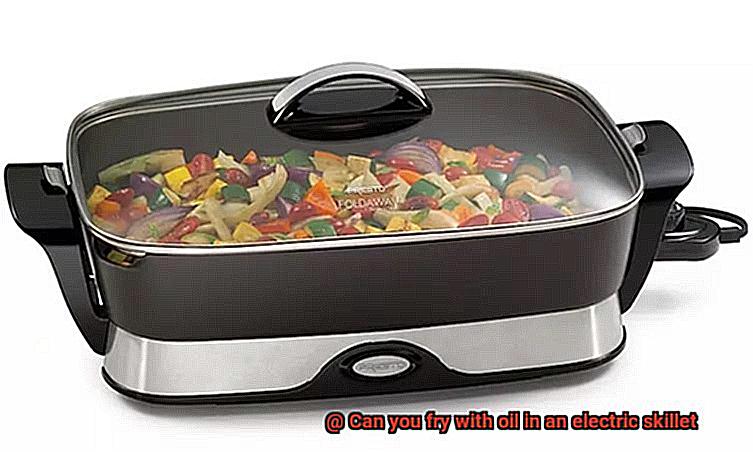
But, here’s something you may not have considered – different types of oil have different smoke points. The smoke point is the temperature at which the oil starts smoking and breaking down, causing a burnt flavor and potentially harmful compounds to form. So, when selecting an oil for frying in your electric skillet, choose one with a high smoke point such as vegetable or peanut oil.
To sum it up, heating the oil in an electric skillet is essential for achieving fried food perfection. The temperature control feature ensures consistency and choosing an oil with a high smoke point guarantees optimal results. So next time you’re ready to fry up some deliciousness, remember these tips for a mouth-watering outcome.
How to Fry Food in an Electric Skillet
Frying food in an electric skillet is a convenient and hassle-free way to achieve perfectly crispy results every time. To ensure that your food comes out just right, there are a few key things to keep in mind.
Choose the Right Oil
The first step to frying food in an electric skillet is choosing the right oil. Vegetable oil, canola oil, and peanut oil are all great options because they have a high smoke point. This means that they won’t burn as easily as other oils, ensuring that your food comes out perfectly crispy.
Preheat Your Skillet
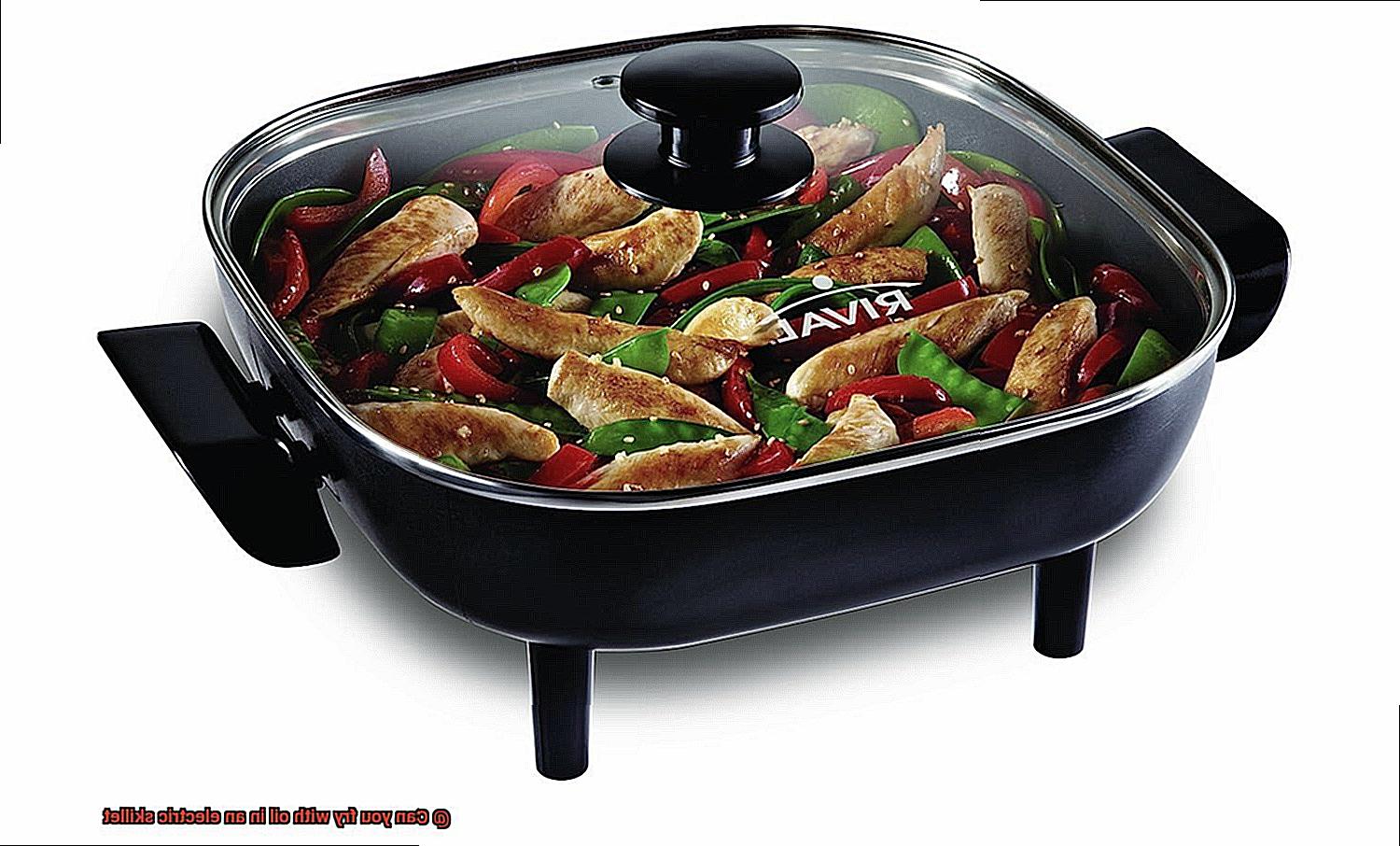
Before you start frying, make sure to preheat your electric skillet to the desired temperature. Most electric skillets have a temperature control dial that allows you to set the temperature between 250-400 degrees Fahrenheit. For frying, you’ll want to set the temperature between 350-375 degrees Fahrenheit. Preheating the skillet ensures that the oil is hot enough to cook your food evenly.
Add Enough Oil
When adding oil to your electric skillet, it’s important not to overfill it with oil. Add enough oil to cover the bottom of the skillet by about 1/2 inch. This will ensure that your food is fully submerged in the hot oil and cooks evenly. Overfilling the skillet with oil can cause it to bubble over and create a mess.
Avoid Overcrowding
One common mistake when frying in an electric skillet is overcrowding the skillet with too much food at once. This can cause the temperature of the oil to drop, resulting in soggy and greasy food. Instead, fry food in batches and allow enough space between each piece for even cooking.
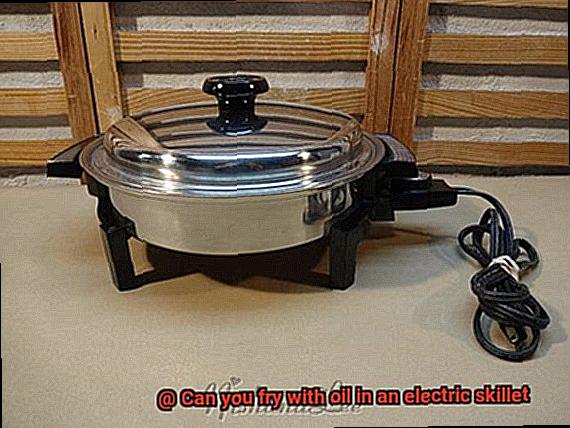
Monitor the Temperature
As you fry your food, be sure to monitor the temperature of the oil and adjust it as needed. If the temperature drops too low, your food will become greasy and soggy. If it gets too hot, it can burn and become overcooked. Using a thermometer can help ensure that you maintain a consistent temperature throughout the frying process.
When your food is done frying, use tongs or a slotted spoon to remove it from the skillet and place it on a paper towel-lined plate to absorb any excess oil. Allow your food to cool for a few minutes before serving.
Tips for Frying with an Electric Skillet
Frying with an electric skillet is a convenient and efficient way to cook fried dishes that are crispy and delicious. However, it’s important to follow certain tips to ensure that your fried foods turn out perfectly.
Choose the Right Oil
Choosing the right oil for frying in an electric skillet is crucial. Different oils have different smoke points, which is the temperature at which they start to break down and produce smoke. For high-temperature frying, such as for chicken or French fries, use an oil with a high smoke point like canola or peanut oil. For lower temperature frying, such as for fish or eggs, use a lighter oil like vegetable or olive oil.
Preheat Your Skillet
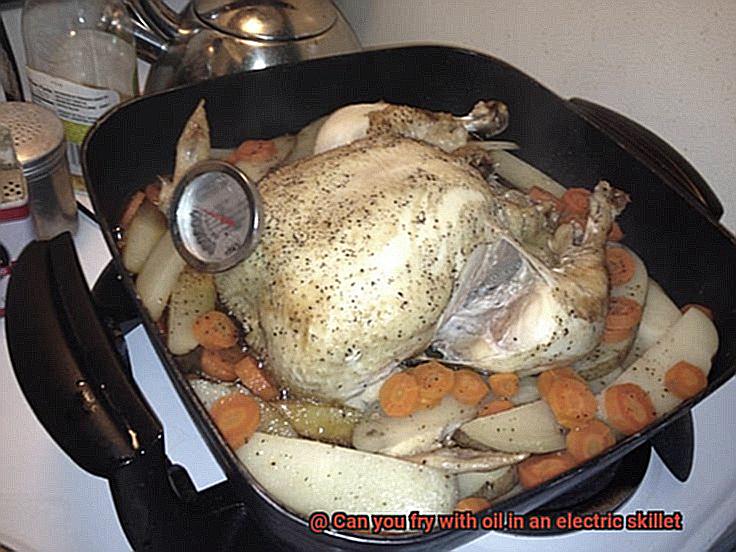
Preheating your skillet before adding oil and food is important to ensure even cooking and prevent sticking. Set the temperature to medium-high and allow it to warm up for a few minutes before adding oil.
Don’t Overcrowd the Skillet
Avoid overcrowding the skillet when frying, as this can cause the temperature of the oil to drop too low, resulting in unevenly cooked food that is greasy and soggy. Instead, fry food in small batches, giving each piece of food enough space to cook properly.
Monitor the Temperature of the Oil
Monitoring the temperature of the oil while frying is important to prevent burning or undercooking your food. If the oil becomes too hot, it can burn the food and create an unpleasant taste and smell. If the oil is not hot enough, it can result in greasy and soggy food. Use a thermometer if necessary to ensure that the temperature of the oil remains between 350°F and 375°F.
Use Tongs or a Slotted Spoon
Using tongs or a slotted spoon while frying can help evenly cook your food and prevent excess oil from transferring onto your plate. As you fry, turn the food occasionally so that it cooks evenly on all sides. Once the food is cooked to your desired level of crispiness, use a slotted spoon or a wire mesh skimmer to remove it from the skillet and drain it on paper towels.
9aw-VQgR264″ >
Conclusion
In conclusion, an electric skillet is a game-changer when it comes to frying. It offers precise temperature control and even heat distribution, ensuring perfectly crispy and evenly cooked fried foods every time. To achieve optimal results, choosing the right oil with a high smoke point is crucial. Preheating the skillet and avoiding overcrowding also ensure even cooking and prevent sticking.
But electric skillets aren’t just for frying. They’re versatile appliances that can be used for simmering or braising too. Plus, they offer convenient features like non-stick surfaces and heat-resistant handles, making them easy to use and clean up after.
If you’re tired of grease splatters on your stove or looking for a more convenient way to cook without babysitting the stove, an electric skillet might just be what you need.

